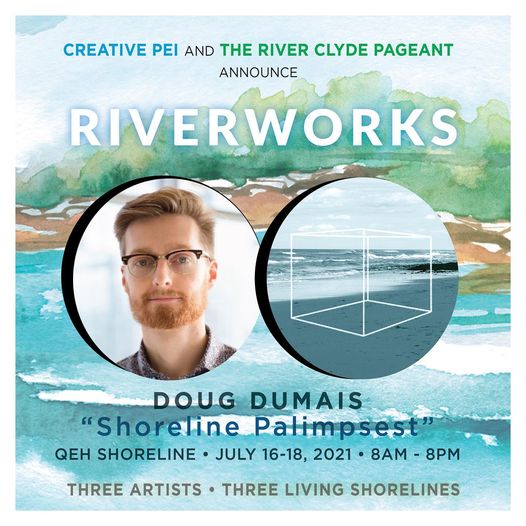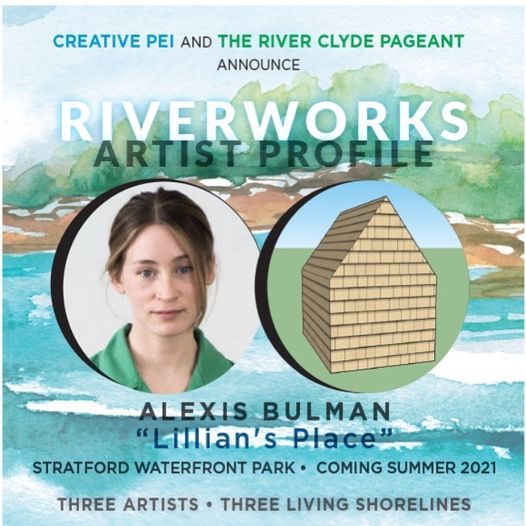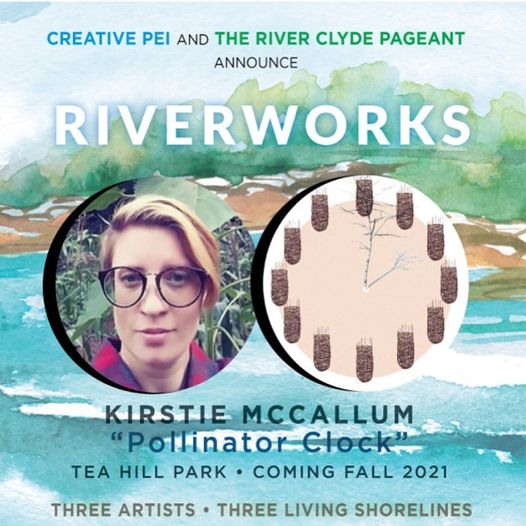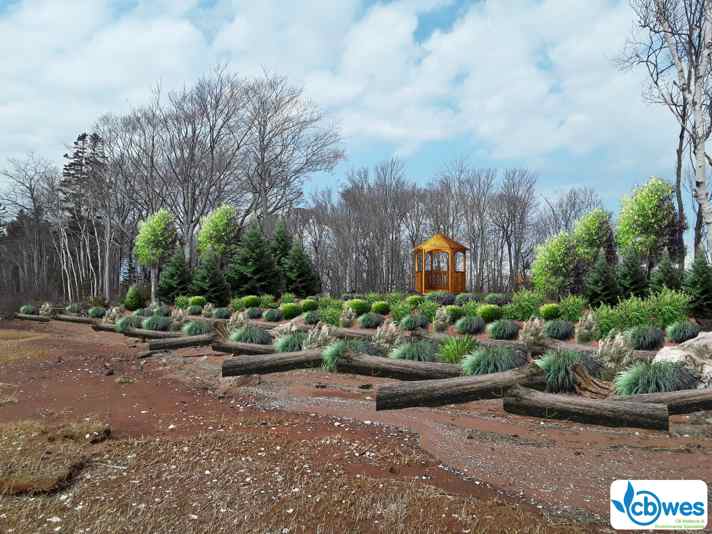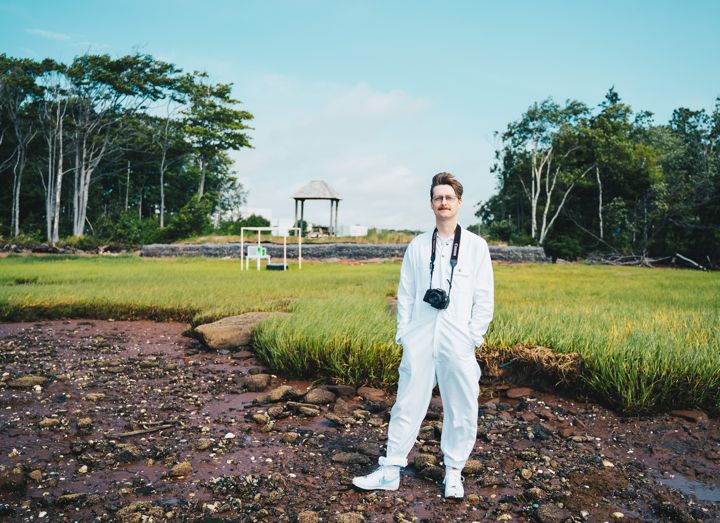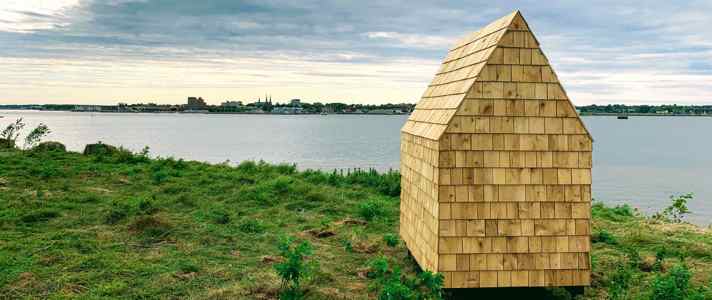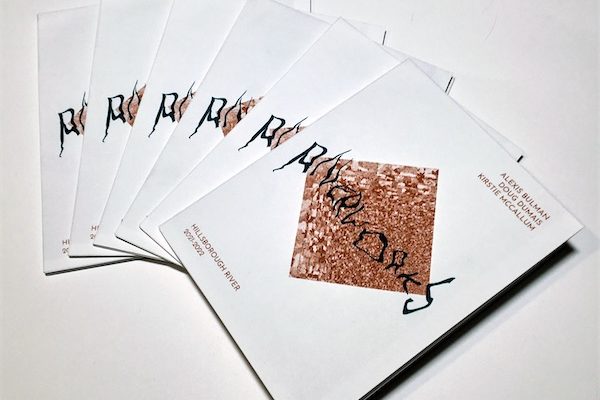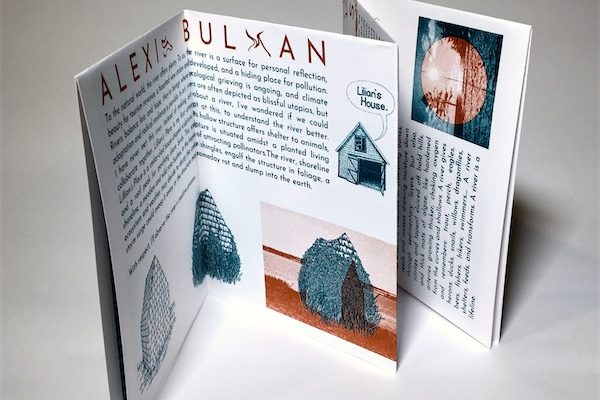Riverworks Zine
RIVERWORKS
Alexis Bulman
Doug Dumais
Kirstie McCallum
Rivière Hillsborough
2021-2022
Alexis Bulman
Pour le monde de la nature, la rivière offre l’abondance. Pour nous, la rivière est une surface pour la réflexion personnelle, une beauté pour les revenus du tourisme, une vue hantée volée et développée, et une couverture pour la pollution. Les rivières concilient la perte et l’espoir, ce sont des créatures où le deuil écologique est en cours, et où l’adaptation au climat et la résilience radicale sont possibles. Dans l’art, les rivières sont souvent représentées comme des utopies bienheureuses, mais je n’ai jamais rencontré une telle rivière. Au lieu de faire de l’art sur une rivière, je me suis demandé si nous pouvions collaborer avec elle. Lillian’s Place (Chez Lilian) est ma première tentative dans ce sens, pour mieux comprendre la rivière. Lillian’s Place est une sculpture en forme de maison recouverte de cèdre. Sa structure creuse offre un abri aux animaux et un faîte de toit aux oiseaux de rivage qui s’y perchent. Cette sculpture est située au milieu d’un rivage vivant aménagé, d’une prairie et de rosiers sauvages, dans l’espoir d’attirer les pollinisateurs. La rivière, l’écosystème du littoral et les conditions météorologiques peuvent décider de décomposer les bardeaux de cèdre, d’engloutir la structure dans le feuillage, de l’emporter dans une vague de tempête ou de la faire pourrir et de l’affaisser dans la terre.
Avec respect, je vais observer le processus créatif de la rivière.
Kirstie McCallum
Pollinator Clock (L’horloge des pollinisateurs) est conçue pour rendre visibles les cycles de croissance et de décroissance. Il s’agit à la fois d’un cadran solaire circulaire et d’un jardin ensemencé de fleurs sauvages. Douze paniers sculpturaux indiquent les heures, tandis que l’ombre d’un bouleau jaune marque le temps. Le temps de la rivière est également cyclique. Les bassins souterrains reçoivent les pluies de printemps et les ruisseaux remontent à la surface dans les champs pour alimenter la floraison de l’été. Les rapides, les tourbières et les marais s’agrandissent avec la fonte des neiges ou se contractent pendant les chaudes journées d’août, tandis que les profondeurs silencieuses de l’eau et la glace hivernale fendent les bancs de sable et s’élancent vers la mer, déployant dans l’océan d’innombrables brins de vert, de brun et d’argent. Animaux, végétaux et minéraux se côtoient, pour le meilleur ou pour le pire : grenouilles ou crustacés dans les vasières, hirondelles dans les berges effritées, roseaux et mousses attirant l’humidité vers le bas à travers les couches sédimentaires, mais aussi nitrites et terre arable provenant des collines chauves, et épais tapis d’algues, comme des artères durcies qui s’épaississent, bloquant l’oxygène des courbes et des creux. Une rivière donne et se souvient : truites, perches, aigles, hérons, canards, escargots, saules, libellules, abeilles, pêcheurs, randonneurs, nageurs… Une rivière abrite, nourrit et transforme. Une rivière est une ressource vitale.
Doug Dumais
Dans la plupart des représentations artistiques de Saint Jean à Patmos écrivant les Révélations, on le voit griffonner furieusement dans un livre, le regard tourné vers le ciel et assis au bord d’une rivière. Ses visions peuvent provenir d’en haut, mais les mots peuvent-ils provenir de la rivière? Les écrits des prophètes sont ambigus, ouverts et fluides. Comme un texte et son interprétation, une rivière peut sembler la même au cours d’une vie, mais son contenu et ses bords changent constamment. Si une prophétie est une conjonction entre des situations présentes et des événements futurs, les artistes fluviaux sont peut-être des prophètes de l’anthropocène : ils traduisent les immensités de la nature et les avertissements de la science en quelque chose que l’on peut emporter avec soi. La rivière peut nous apprendre tant de choses sur le deuil, l’effacement de toutes choses ou l’écoulement irréversible du temps. Shoreline Palimpsest (Le palimpseste du rivage) était une performance d’endurance au cours de laquelle j’ai passé cinq jours de 12 heures sur le rivage dans un cube de studio extérieur que j’ai fabriqué moi-même, prenant des photos et écrivant des poèmes en réponse à mes observations du rivage. Je ne suis en aucun cas un prophète, mais après avoir passé tout ce temps sur le rivage, à prendre des photos et à gribouiller furieusement, une question demeure : que pouvons-nous enseigner à la rivière? Je ne peux qu’être embarrassé et espérer qu’elle ne le demande pas.
Dos de couverture
Riverworks est une initiative de The River Clyde Pageant et de Creative PEI dans le cadre de laquelle trois artistes ont créé en 2021 des œuvres d’art publiques en plein air qui explorent la transformation écologique. Chaque œuvre d’art a été installée à l’un des trois sites de rivage vivant le long de la rivière Hillsborough à Charlottetown et à Stratford. Utiliser la carte au verso de ce document pour visiter ces sites.
Balayer ce code pour accéder au catalogue de l’exposition dans d’autres langues.
L’initiative des rivages vivants a été menée par PEI Watershed Alliance et soutenue par le Fonds d’action pour le climat du gouvernement fédéral.
Verso (carte)
Conception de la carte : Quinn Howard
Doug Dumais
Shoreline Palimpsest
Alexis Bulman
Lilian’s Place
Kirstie McCallum
Pollinator Clock
